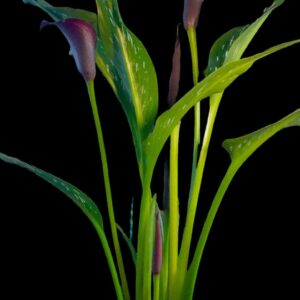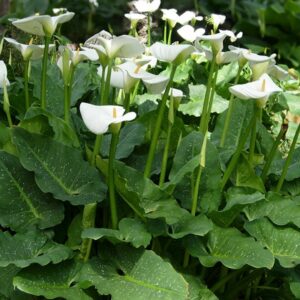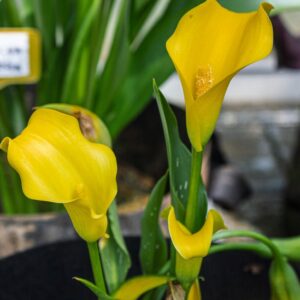Your cart is currently empty!
Calla Lilies: A Comprehensive Guide to Care and Cultivation

Introduction
Calla lilies (Zantedeschia spp.) are beautiful, elegant flowers known for their distinctive trumpet-shaped blooms and glossy, arrow-shaped leaves. Native to southern Africa, these plants have become popular in gardens and floral arrangements worldwide. This comprehensive guide provides detailed information on calla lily care, cultivation, and troubleshooting.
Types of Calla Lilies
There are over a dozen species of calla lilies, each with its unique characteristics:
-
Z. aethiopica:
The classic white calla lily with large, pure white blooms.
-
Z. albomaculata:
Features spotted white flowers with purple or green blotches.
-
Z. elliottiana:
Produces bright yellow blooms that fade to orange as they age.
-
Z. rehmannii:
Boasts unique black flowers with yellow centers.
-
Z. albomaculata ‘Green Goddess’:
Has attractive green flowers with white edges.
Growing Conditions
-
Light:
Prefers bright, indirect light. Can tolerate partial shade but may produce fewer blooms.
-
Temperature:
Thrives in temperatures between 60-75°F (16-24°C). Protect from extreme heat and cold.
-
Soil:
Requires well-draining, fertile soil rich in organic matter.
-
Watering:
Water regularly, keeping the soil moist but not waterlogged. Allow the top inch of soil to dry out between waterings.
-
Humidity:
Prefers high humidity. Mist the leaves regularly or use a humidifier.
Propagation
Z. aethiopica:
The classic white calla lily with large, pure white blooms.
Z. albomaculata:
Features spotted white flowers with purple or green blotches.
Z. elliottiana:
Produces bright yellow blooms that fade to orange as they age.
Z. rehmannii:
Boasts unique black flowers with yellow centers.
Z. albomaculata ‘Green Goddess’:
Has attractive green flowers with white edges.
-
Light:
-
Temperature:
-
Soil:
-
Watering:
-
Humidity:
Prefers bright, indirect light. Can tolerate partial shade but may produce fewer blooms.
Thrives in temperatures between 60-75°F (16-24°C). Protect from extreme heat and cold.
Requires well-draining, fertile soil rich in organic matter.
Water regularly, keeping the soil moist but not waterlogged. Allow the top inch of soil to dry out between waterings.
Prefers high humidity. Mist the leaves regularly or use a humidifier.
Propagation
Calla lilies can be propagated by division or seed:
-
Division:
In spring or fall, divide established plants into smaller clumps and replant them.
-
Seed:
Sow seeds indoors in late winter or early spring. Keep the soil warm and moist for germination.
Care and Maintenance
-
Fertilizing:
Fertilize every 2-3 weeks with a balanced liquid fertilizer.
-
Pruning:
Remove spent flowers and yellowing or damaged leaves to promote growth and flowering.
-
Overwintering:
In cold climates, calla lilies need to be protected from frost. Dig up the bulbs in fall and store them indoors in a cool, dry place. Replant in spring.
Troubleshooting Common Issues
-
Yellowing Leaves:
- Overwatering
- Nutrient deficiency
- Pest infestation
-
Brown Leaf Tips:
- Underwatering
- Low humidity
- Salt buildup
-
Lack of Blooms:
- Insufficient light
- Overcrowding
- Nutrient deficiency
-
Pests and Diseases:
- Aphids
- Spider mites
- Root rot
Conclusion
Division:
In spring or fall, divide established plants into smaller clumps and replant them.
Seed:
Sow seeds indoors in late winter or early spring. Keep the soil warm and moist for germination.
-
Fertilizing:
-
Pruning:
-
Overwintering:
Fertilize every 2-3 weeks with a balanced liquid fertilizer.
Remove spent flowers and yellowing or damaged leaves to promote growth and flowering.
In cold climates, calla lilies need to be protected from frost. Dig up the bulbs in fall and store them indoors in a cool, dry place. Replant in spring.
Troubleshooting Common Issues
-
Yellowing Leaves:
- Overwatering
- Nutrient deficiency
- Pest infestation
-
Brown Leaf Tips:
- Underwatering
- Low humidity
- Salt buildup
-
Lack of Blooms:
- Insufficient light
- Overcrowding
- Nutrient deficiency
-
Pests and Diseases:
- Aphids
- Spider mites
- Root rot
Conclusion
Yellowing Leaves:
- Overwatering
- Nutrient deficiency
- Pest infestation
Brown Leaf Tips:
- Underwatering
- Low humidity
- Salt buildup
Lack of Blooms:
- Insufficient light
- Overcrowding
- Nutrient deficiency
Pests and Diseases:
- Aphids
- Spider mites
- Root rot
Calla lilies add elegance and beauty to any garden or floral arrangement. By understanding their specific care requirements and providing them with optimal growing conditions, you can enjoy these stunning flowers for years to come. Whether you are a seasoned gardener or a novice looking to enhance your outdoor space, this comprehensive guide will empower you to cultivate thriving calla lilies.








Leave a Reply